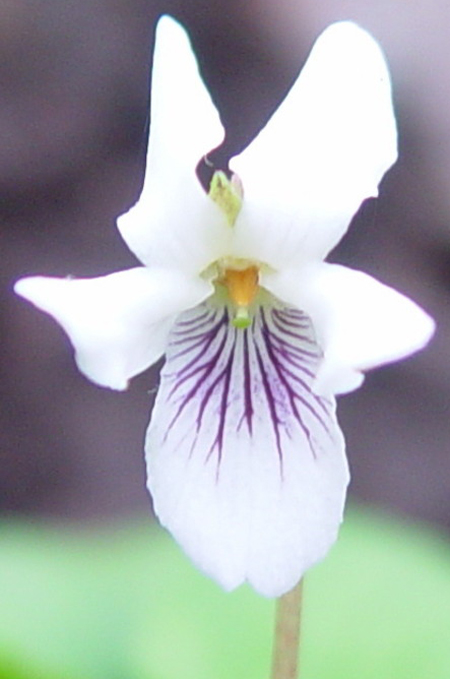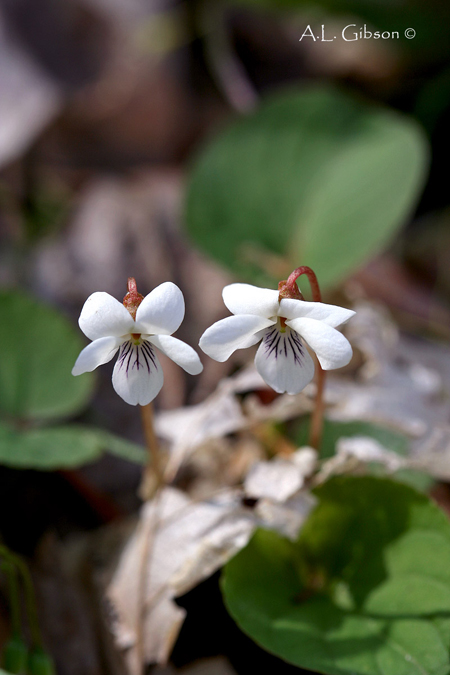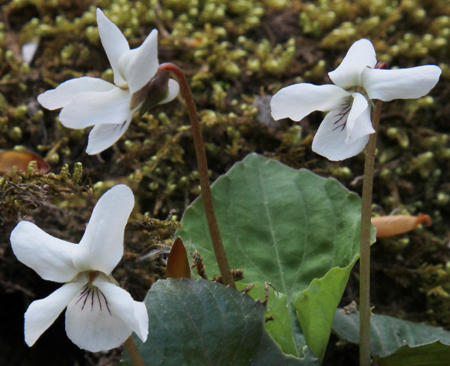Viola blanda Willd.
Common names:
Sweet White Violet
Synonyms:
Viola blanda Willd., Hort. Berol. [Willdenow] 1(2): pl. 24. 1804. TYPE: [illustration] Willdenow, Hort. Berol.: pl. 24. 1804 (LECTOTYPE (designated by T. Y. S. Choo et al., Taxon 63(3): 690. 2014)).
Viola alsophila Greene, Pittonia 4: 7. 1899 [replacement name for V. amoena Leconte (1828) non V. amoena T.F.Forst. (1798)]; Viola amoena Leconte, Ann. Lyceum Nat. Hist. New York 2: 144. 1828 ['1826']
Viola blanda Willd. var. amoena (Leconte) Britton, Sterns & Poggenb., Prelim. Cat.: 6. 1888
Viola burtonii Reeks, List Fl. Pl. Ferns Newfoundland: 2. 1873
Viola leconteana G.Don, Gen. hist. 1: 324. 1831
Viola pallens T.F.Forst. ex Schult., in Roem. & Schult., Syst. veg. 5: 359. 1819
Description:
Acaulescent stoloniferous perennials from slender rhizome, stolons surficial, colonial from surficial stolons produced in summer, stolons bearing multiple nodes each with a leaf and cleistogamous capsule, ≤ 17 cm tall; foliage and peduncles pale gray-green with upper surface of leaf blades darker, petioles, peduncles and calyx red-tinged or -spotted, leaves glabrous except for scattered hairs on upper leaf blade surfaces, peduncles glabrous; stipules free, glandular-fimbriate; leaves spreading, leaf blades undivided, largest ≤ 69 × 62 mm, narrowly ovate, base deeply cordate with inner edges of lobes attingent or overlapping in life, sinus < 1/4 length of blade, margins crenate, eciliate, apex acute; chasmogamous peduncle held among the leaves; chasmogamous flower ≤ 11.0 mm; calyx glabrous, eciliate; lowest sepals ovate-lanceolate to ovate, acutish to rounded; auricles short and entire, not elongating in fruit; corolla white, throat greenish-white; spur short-globose; all petals glabrous; chasmogamous capsule green or with fine red spots; cleistogamous flowers produced after chasmogamous, on prostrate peduncle much shorter than petioles, arching upward and sometimes surpassing petioles just before capsule dehiscence; cleistogamous capsule 6–8 mm, green drying tan with red-purple to purple spots or blotches, glabrous; seeds 1.2–1.3 × 0.7–0.8 mm, brownish-blackish, unspotted; 2n=44.
Similar species:
This species can be distinguished from V. incognita in its commonly red-tinged petioles and peduncles, pubescence (if present) restricted to subappressed hairs on the upper surface of the leaf blades, largest leaf blades narrowly ovate with short deep basal sinus and lobes with inner edges commonly overlapping and acute apex, glabrous lateral petals, summer stolons with leaves and cleistogamous capsules distributed along their length, and broadly obovoid dark brown seeds. The leaf blade margins are shallowly crenate, similar to V. minuscula, rather than noticeably low-serrate as in V. incognita (check this on the margins at the widest point on the leaf blade). It differs from V. minuscula in the upper surface of the leaf blades commonly bearing subappressed hair, glabrous petioles, and heavily spotted cleistogamous capsule on a prostrate peduncle. It is different from some coastal and southeastern populations of V. primulifolia with subcordate or shallowly cordate leaf bases in having the leaf blade base deep with inner edges of the basal lobes touching or overlapping, glabrous foliage or hairs limited to the upper surface of the leaf blades, and heavily spotted cleistogamous capsule on a prostrate peduncle. It is easily distinct from V. renifolia in the elevated narrowly ovate leaf blades with acute apex, pubescence (if present) restricted to short subappressed hairs on the upper surface of the leaf blades, and broadly obovoid dark brown seeds.
Ecology:
Moist organic loamy or sandy loam soils in mesic northern hardwood forests, base of slopes with seepage in drier forests, along streams, often under conifers (e.g., Tsuga), at higher elevations or northern microclimates.
Distribution:
Appalachian Mountains and associated uplands, ME to VT and c KY, sout to NC, n. GA and e. TN, slightly disjunct in se. IN (reports from the western Great Lakes and Midwest are misidentifications).
Rarity:
State listed in IN.
Phenology:
Chasmogamous flower April–June, chasmogamous fruit June–July, cleistogamous fruit June–Septembter.
Affinities:
This species belongs to the Acaulescent White Violet lineage, sect. Plagiostigma Godron, subsect. Stolonosae (Kupffer.) Kupffer.
Hybrids:
Hybridizes with V. incognita (Russell 1954, 1955c, 1965); hybrids are probably much more common than the very limited reports suggest. Hybrids with V. minuscula and V. renifolia should be sought, given the overlaps in range in the Appalachian Mountains and adjacent uplands (for the former) and the more northeasterly portion of our region (for the latter), and occasional to frequent local sympatry. Hybrids would fail to reproduce by chasmogamous flowers, would have sterile pollen, and would very likely produce abortive cleistogamous capsules or capsules with no viable seeds, simply due to the difference in ploidy level. Hybrids with V. incognita would presumably fail to reproduce chasmogamously and might also express reduced cleistogamous seed output. Studies are needed to confirm these predictions.
Comments:
Brainerd (1921b), Brainerd Baird (1942), Fernald (1950), Henry (1953a), Russell (1955c, 1965), Alexander (1963), Scoggan (1978), Strausbaugh and Core (1978), and Weakley et al. (2012) maintained this as a distinct species separate from V. incognita. Haines et al. (2011) merged the two but maintained two varieties, var. blanda and var. palustriformis Brainerd, while Gleason and Cronquist (1991), Ballard (1995, 2000), Voss and Reznicek (2012), and Little and McKinney (2015) synonymized V. incognita under V. blanda without infraspecific recognition. Brainerd, Fernald, Alexander and Scoggan erroneously reported the range extending west to Wisconsin, Minnesota and Illinois, whereas Russell and others pointed out that typical V. blanda is virtually confined to the Appalachian highlands and associated uplands and does not range further west than southern Indiana, with reports from outside that narrower region representing misidentifications of other species. Nearly glabrous plants of V. incognita formerly called var. forbesii Brainerd, with indument restricted to the upper surface of leaf blades, can sometimes appear similar to V. blanda when chasmogamous flower and cleistogamous fruit characters are ignored. The shape of the largest leaf blades and coloration of the foliage and peduncles are somewhat variable and less reliable during chasmogamous flower, and best interpreted on summer fruiting plants. The trait of twisted versus non-twisted petals as a distinguishing feature used in some keys has been elusive to me, and I've preferentially relied more heavily on other features presented in the keys. As yet unclear levels of within-population and regional variation in V. blanda and V. incognita render determination of the extent of hybridization difficult, but (surprisingly) studies of hybridization are lacking. The extremes, which are very common, are highly divergent in several features of foliage, chasmogamous flowers and seeds and are thus treated as distinct evolutionary species. Chasmogamous flowering plants of this species with leaves not fully expanded can be particularly difficult to identify with confidence from V. incognita, whereas cleistogamous fruiting plants in summer express quite conspicuous differences in foliage and peduncle color, leaf shape and indument, and cleistogamous seeds. Choo et al. (2014) have proposed conservation of the widely used name V. blanda Willd. (1804) against the earlier neglected name V. blanda Salisb. (1796, now a synonym of the European pansy V. cornuta L.).
Literature Cited:
Alexander, E. J. 1963. Violaceae. In Gleason, H. A., The new Britton and Brown illustrated flora of the northeastern United States and adjacent Canada. Hafner Publishing Co., Inc., New York, NY. 552-567.
Ballard Jr., H. E. 1995 ["1994"]. Violets of Michigan. Michigan Botanist 33: 131-199.
Ballard Jr., H. E. 2000. Violaceae. In Rhoads, A. (ed.). Flora of Pennsylvania. University of Pennsylvania Press, Philadelphia, PA. 700-710.
Brainerd, E. 1921b. Violets of North America. Vermont Agricultural Experiment Station Bulletin 224: 1–172.
Brainerd Baird, V. 1942. Wild violets of North America. University of California Press, Berkeley, CA.
Choo, T. Y. S., K. N. Gandhi, J. H. Wiersema, C. E. Jarvis, and J. L. Reveal. 2014. Proposal to conserve the name Viola blanda Willd. against Viola blanda Salisb. (Violaceae). Taxon 63: 690–691.
Fernald, M. L. 1950. Violaceae. In Gray’s Manual of Botany, 8th ed. American Book Company, New York, NY. 1022-1042.
Gleason, H. A., and A. Cronquist. 1991. Violaceae. In Manual of vascular plants of northeastern United States and adjacent Canada, 2nd ed. New York Botanical Garden, Bronx, NY. 157-163.
Haines, A., E. Farnsworth, and G. Morrison. 2011. Violaceae. In Flora Novae Angliae. Yale University Press, New Haven, CT. 873-886.
Henry, L. K. 1953a. The Violaceae in western Pennsylvania. Castanea 18(2): 37-59.
Little, R. J., and L. E. McKinney. 2015. Violaceae. In Flora of North America: Cucurbitaceae to Droseraceae, 106. Oxford University Press, New York, NY.
Russell, N. H. 1954. Three field studies of hybridization in the stemless white violets. American Journal of Botany 41: 679–686.
Russell, N. H. 1955c. The taxonomy of the acaulescent white violets. American Midland Naturalist 54: 481–494.
Russell, N. H. 1965. Violets (Viola) of the central and eastern United States: An introductory survey. Sida 2: 1–113.
Scoggan, H. J. 1978. Violaceae. In Flora of Canada, Part 3–Dicotyledoneae (Saururaceae to Violaceae). National Museums of Canada. Ottawa, Canada. 1103-1115.
Strausbaugh, P. D., and E. L. Core. 1978. Violaceae. In Flora of West Virginia, 2nd ed. Seneca Books, Inc., Morgantown, WV. 644-658.
Voss, E. G., and A. A. Reznicek. 2012. Violaceae. In Field manual of Michigan flora. The University of Michigan Press, Ann Arbor, MI. 913-922.
Weakley, A. S., J. C. Ludwig, and J. F. Townsend. 2012. Violaceae. In Flora of Virginia. BRIT Press, Fort Worth, TX. 963-975.

Chasmogamous flowering habit by Andrew Gibson, "Buckeye Botanist" website

Chasmogamous flowering habit by Bruce Sorrie

Leaves by Arthur Haines, Native Plant Trust

Chasmogamous flower front view by Arthur Haines, Native Plant Trust

Chasmogamous flower front view by Andrew Gibson, "Buckeye Botanist" website

Chasmogamous flower front and profile views by Andrew Gibson

Chasmogamous fruit by Arthur Haines, Native Plant Trust

Seeds from herbarium specimen: CT, New London Co., North Stonington, C. A. Weatherby s.n. (CBS17933)